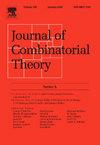分离哈希族与大宇宙
IF 1.2
2区 数学
Q2 MATHEMATICS
引用次数: 0
摘要
分离哈希族是一种有用的组合结构,它概括了密码学和编码理论中几个研究得很好的对象。设pt(N,q)表示长度为N的t-完美哈希族在大小为q的字母表上的最大空间大小。本文证明了对于所有t≥3,q2−o(1)<pt(t,q)=o(q2),这回答了Blackburn等人在2008年针对某些参数提出的关于分离哈希族的开放问题。以前,只有在t=3,4时才知道这个结果。我们的证明是通过建立一个大整数集的存在性而得到的,该整数集避免了一组相关线性方程的非平凡解。本文章由计算机程序翻译,如有差异,请以英文原文为准。
Separating hash families with large universe
Separating hash families are useful combinatorial structures which generalize several well-studied objects in cryptography and coding theory. Let denote the maximum size of universe for a t-perfect hash family of length N over an alphabet of size q. In this paper, we show that for all , which answers an open problem about separating hash families raised by Blackburn et al. in 2008 for certain parameters. Previously, this result was known only for . Our proof is obtained by establishing the existence of a large set of integers avoiding nontrivial solutions to a set of correlated linear equations.
求助全文
通过发布文献求助,成功后即可免费获取论文全文。
去求助
来源期刊
CiteScore
2.90
自引率
9.10%
发文量
94
审稿时长
12 months
期刊介绍:
The Journal of Combinatorial Theory publishes original mathematical research concerned with theoretical and physical aspects of the study of finite and discrete structures in all branches of science. Series A is concerned primarily with structures, designs, and applications of combinatorics and is a valuable tool for mathematicians and computer scientists.

 求助内容:
求助内容: 应助结果提醒方式:
应助结果提醒方式:


